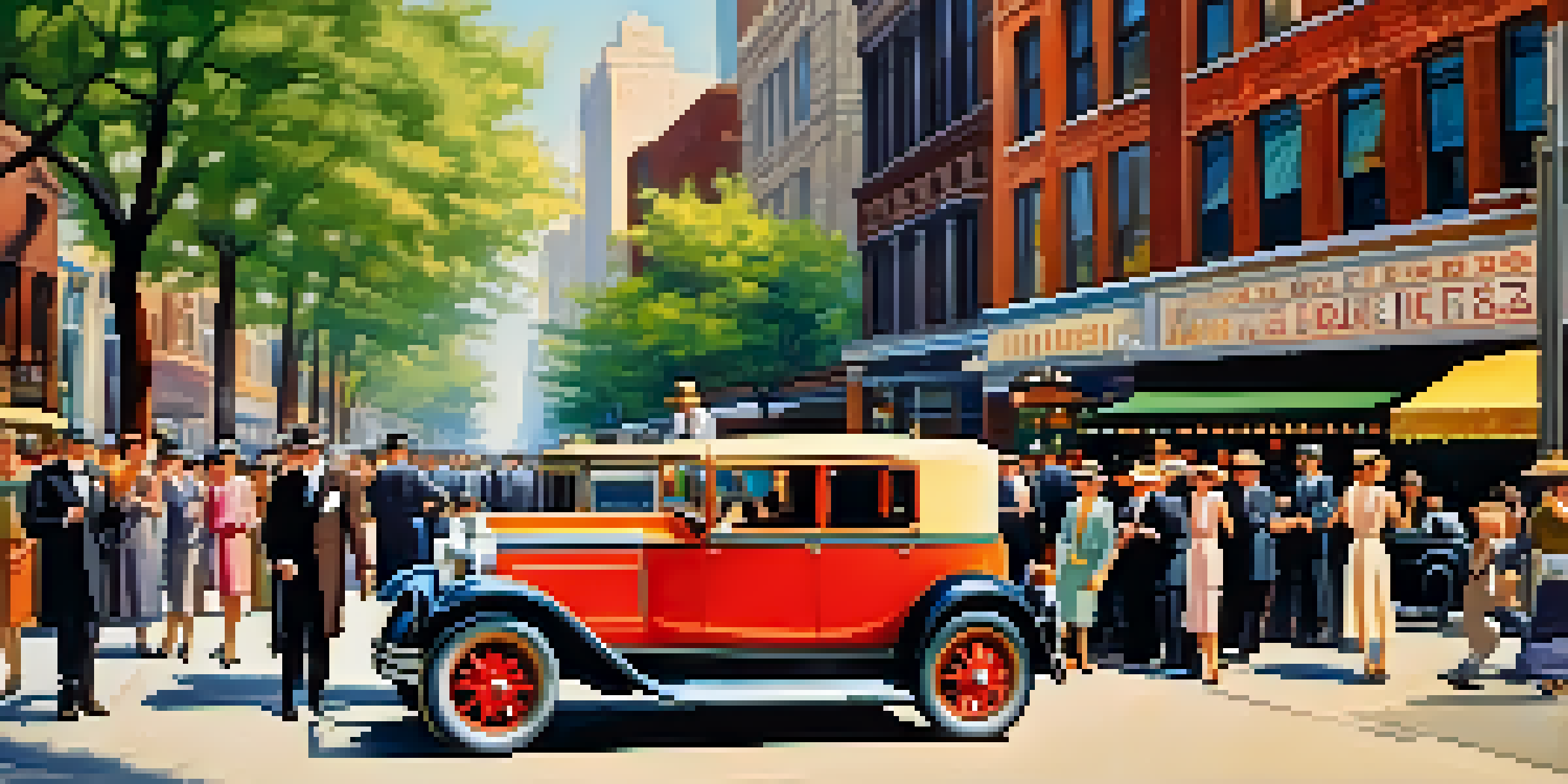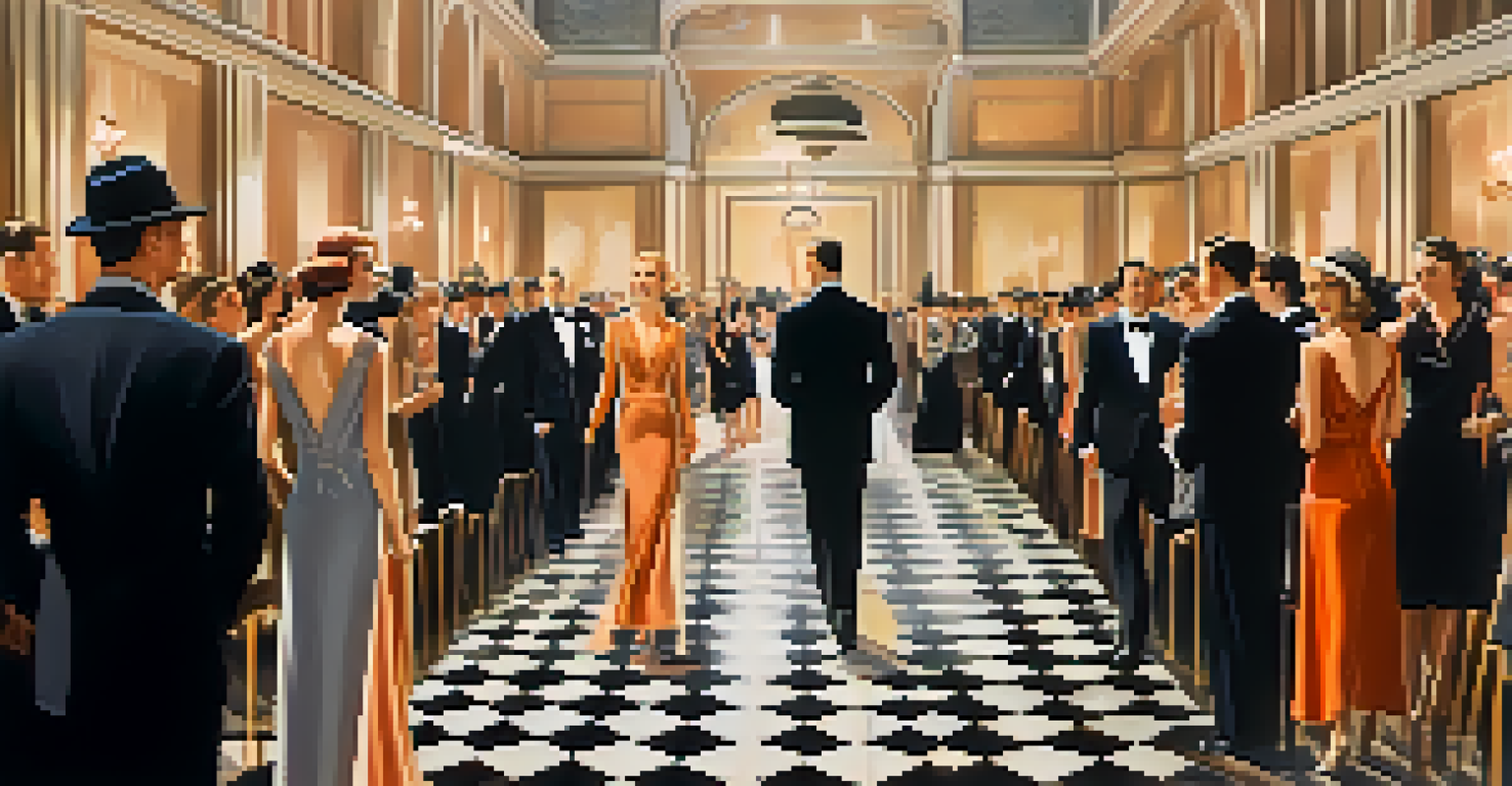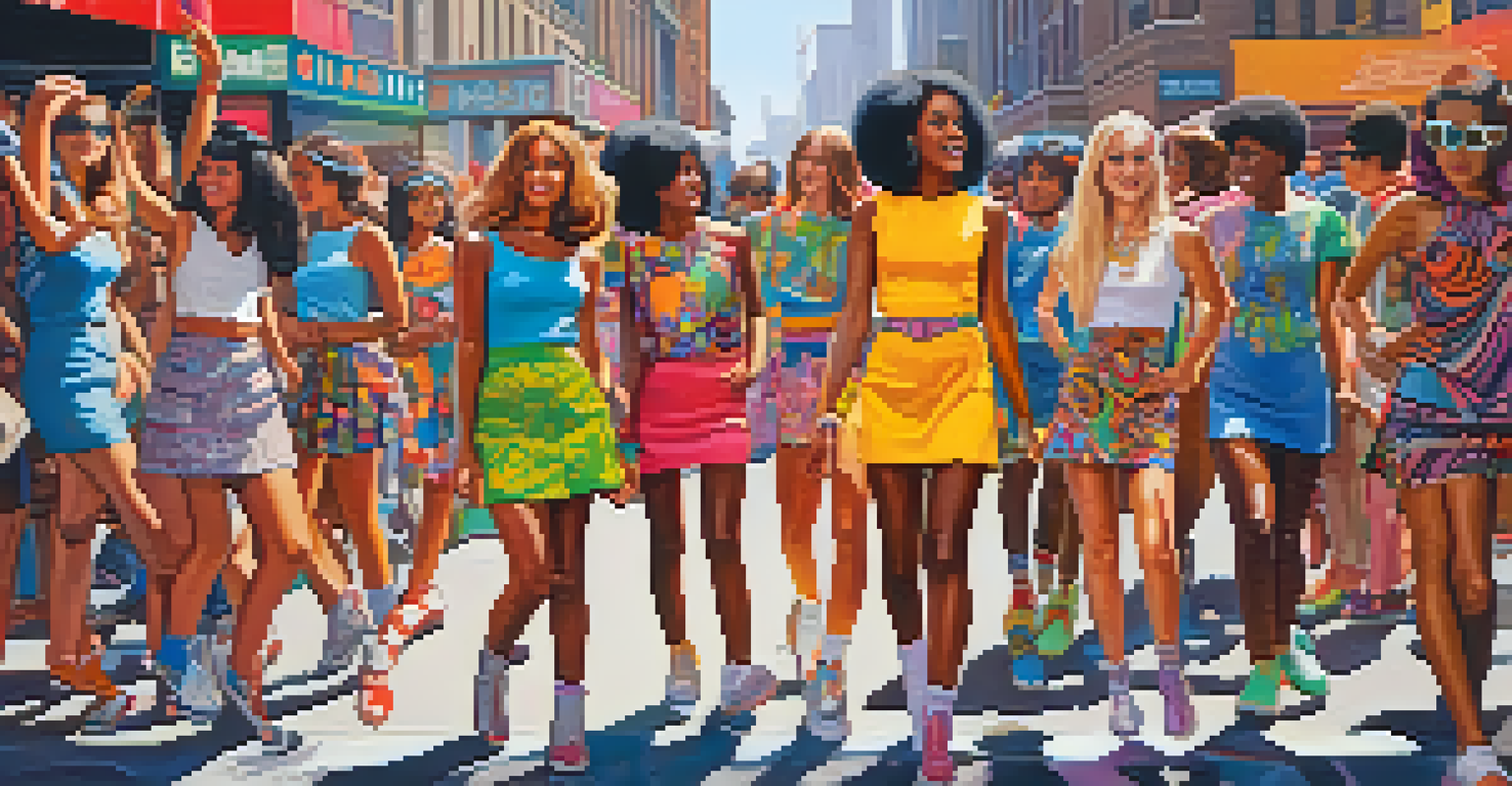Exploring the Evolution of Chicago's Fashion Scene Over Decades

The Roaring Twenties: Chic and Bold Styles Take Center Stage
The 1920s in Chicago marked a transformative time for fashion, as the Roaring Twenties brought a sense of liberation and exuberance. Women embraced shorter hemlines and dropped waists, reflecting newfound freedoms, while men donned sharp suits and fedoras. This era saw the rise of jazz culture, influencing styles that were both daring and glamorous, often characterized by lavish fabrics and intricate embellishments.
Fashion is the armor to survive the reality of everyday life.
Chicago's fashion scene was vibrant, with department stores like Marshall Field's leading the charge in retail innovation. These stores became social hubs, showcasing the latest trends and fostering a sense of community among shoppers. The influence of Art Deco also made its way into fashion, with geometric patterns and bold colors becoming staples of the decade.
As the decade progressed, Chicago's fashion mirrored the rapid changes in society, paving the way for future generations. The excitement and creativity of the 1920s set a high bar for the evolving fashion landscape, leaving a lasting imprint on the city's identity.
The 1930s: Elegance Meets Economic Hardship
The 1930s brought a shift in fashion as the Great Depression affected both the economy and people's wardrobes. While luxury was still sought after, practicality became paramount, leading to more subdued styles. Women wore tailored dresses and suits that emphasized a clean silhouette, often accessorized with hats and gloves, creating an aura of understated elegance.

In Chicago, fashion designers began to adapt to the changing times, focusing on quality over quantity. This led to the rise of ready-to-wear fashion, making stylish clothing more accessible to the average consumer. Local designers emerged, showcasing their work at the Chicago World’s Fair in 1933, which highlighted innovation and creativity within the city.
Fashion Reflects Cultural Shifts
Each decade in Chicago showcases how fashion adapts to societal changes, from the liberation of the 1920s to the diverse expressions of the 1970s.
Despite the challenges of the era, Chicagoans embraced fashion as a form of self-expression. The resilience shown during this period laid the groundwork for the bold styles that would follow in the subsequent decades, proving that even in tough times, style can flourish.
The 1940s: War Influence on Fashion and Functionality
The 1940s were heavily influenced by World War II, which brought significant changes to fashion due to rationing and resource limitations. Clothing was designed with functionality in mind, leading to shorter hemlines and simpler cuts that allowed for ease of movement. Women's fashion, in particular, saw a shift as they entered the workforce, leading to the popularity of practical yet stylish outfits.
Style is a way to say who you are without having to speak.
In Chicago, designers creatively adapted to these constraints by using innovative materials and techniques. The iconic 'New Look' introduced by Christian Dior in 1947 inspired many local designers to explore more feminine silhouettes, featuring cinched waists and full skirts, signaling a shift back to more luxurious styles as the war came to an end.
This decade showcased the resilience of Chicago's fashion scene, as local boutiques and department stores offered creative solutions to the challenges posed by the war. The influence of military fashion remained strong, but the yearning for elegance and femininity began to resurface as society transitioned back to peacetime.
The 1950s: A Decade of Glamour and Individuality
The 1950s marked a return to glamour and individuality in Chicago's fashion scene. The post-war era saw a flourishing of styles that celebrated femininity, with the hourglass silhouette becoming a symbol of the time. Women embraced full skirts, fitted bodices, and vibrant colors, while men opted for classic tailored suits, reflecting a desire for sophistication and elegance.
Chicago's fashion industry thrived during this decade, with designers experimenting with new materials and cuts. The rise of youth culture led to the emergence of subcultures, each with its own distinct style, from greasers to preppies. This diversity highlighted the city's rich cultural tapestry and the influence of music and film on fashion trends.
Resilience Through Economic Hardship
Despite challenges like the Great Depression, Chicago's fashion scene evolved to emphasize practicality while maintaining elegance.
The 1950s also saw the birth of fashion icons, such as Marilyn Monroe and James Dean, whose styles resonated deeply with Chicagoans. The combination of glamour, individuality, and cultural influence made this decade a pivotal moment in the evolution of the city's fashion identity.
The 1960s: Revolution and the Rise of Street Fashion
The 1960s brought a cultural revolution that transformed not only society but also the fashion landscape in Chicago. As youth movements gained momentum, bold styles emerged, reflecting a spirit of rebellion and self-expression. Mini skirts, psychedelic prints, and vibrant colors became symbols of the decade, influencing how people dressed on the streets.
Chicago's fashion scene embraced this shift, with boutiques popping up to cater to the new generation's desire for unique and expressive clothing. Designers began to draw inspiration from music, art, and social movements, leading to a blend of styles that celebrated creativity and individualism. This was also the era when fashion began to intersect with politics, as clothing became a form of activism.
As the decade progressed, the fashion industry became increasingly inclusive, showcasing diverse voices and styles. The 1960s laid the groundwork for future fashion movements in Chicago, emphasizing the importance of personal style and cultural expression.
The 1970s: Diversity and the Bohemian Influence
The 1970s were characterized by a vibrant mix of styles in Chicago, as fashion became a reflection of personal identity and cultural diversity. The bohemian influence brought flowing fabrics, fringe, and earth tones to the forefront, encouraging individuals to embrace a more relaxed and natural aesthetic. This decade celebrated freedom and creativity, allowing for a fusion of different cultural influences in fashion.
As disco culture emerged, so did a flamboyant style that included sequins, bold prints, and daring silhouettes. Chicago's nightlife thrived, with dance clubs serving as a runway for those eager to showcase their unique styles. The contrast between bohemian and disco fashions highlighted the rich tapestry of the city's fashion scene during this time.
Sustainability in Modern Fashion
Today's Chicago fashion landscape focuses on sustainability and inclusivity, blending innovation with the city's rich historical influences.
Moreover, the 1970s saw the rise of influential designers who pushed boundaries and challenged norms. This spirit of experimentation resonated throughout Chicago, making it a hotspot for avant-garde fashion and setting the stage for the eclectic styles of the future.
The 1980s: Bold Statements and Iconic Styles
The 1980s were all about making bold fashion statements, and Chicago was no exception. The decade embraced excess, with big hair, shoulder pads, and vibrant colors dominating the scene. Fashion became a way to express power and confidence, often influenced by pop culture icons like Madonna and Prince, who inspired Chicagoans to embrace their individuality.
Local designers and boutiques thrived during this time, creating unique pieces that reflected the eclectic nature of the city. The rise of streetwear and urban fashion also gained momentum, with hip-hop culture influencing styles and introducing new trends. Chicago's fashion landscape became a melting pot of influences, showcasing a rich blend of creativity and diversity.

As fashion magazines highlighted the boldness of the 1980s, Chicagoans eagerly adopted these trends, making them their own. This decade was a celebration of self-expression, setting a precedent for future generations to continue pushing the boundaries of style.
The 1990s to Today: A Fusion of Styles and Sustainability
As we moved into the 1990s and beyond, Chicago's fashion scene began to reflect a more global perspective, integrating various cultural influences and styles. The '90s saw the rise of grunge and minimalism, with fashion icons embracing a more laid-back aesthetic. Local designers began to experiment with sustainable practices, recognizing the importance of ethical fashion in a rapidly changing world.
Today, Chicago's fashion landscape is a vibrant mix of innovation and tradition, with an emphasis on sustainability and inclusivity. The city is home to a diverse array of designers who draw inspiration from its rich history while also looking to the future. From streetwear to haute couture, the city continues to push the boundaries of style and creativity.
As we reflect on the evolution of Chicago's fashion scene, it's clear that each decade has contributed to the rich tapestry of the city's identity. The journey from the 1920s to today showcases a continual adaptation to cultural shifts, highlighting the importance of fashion as a means of expression and connection within the community.